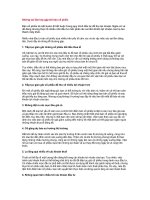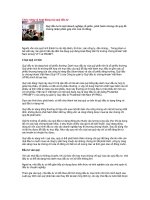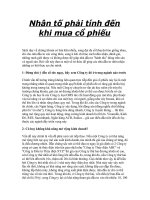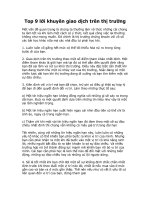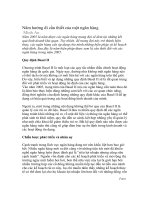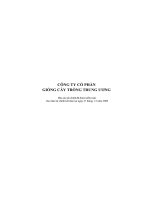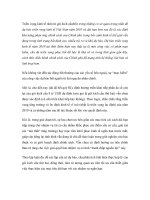Tài liệu EUROPEAN BANKING AUTHORITY 2011 EU-WIDE STRESS TEST AGGREGATE REPORT pptx
Bạn đang xem bản rút gọn của tài liệu. Xem và tải ngay bản đầy đủ của tài liệu tại đây (1.28 MB, 39 trang )
EUROPEAN BANKING AUTHORITY
2011 EU-WIDE STRESS TEST
AGGREGATE REPORT
2
15 July 2011
Executive summary
The stress test exercise. The 2011 EBA’s EU wide stress test had the objective
of assessing the resilience of a large sample of banks in the EU
1
against an
adverse but plausible scenario. The scenario assesses banks against a
deterioration from the baseline forecast in the main macroeconomic variables
such as GDP, unemployment and house prices – for instance, GDP would fall 4
percentage points from the baseline. The scenario includes a sovereign stress,
with haircuts applied to sovereign and bank exposures in the trading book and
increased provisions for these exposures in the banking book. Changes in interest
rates and sovereign spreads also affect the cost of funding for banks in the stress.
The stress testing methodology, which was published by the EBA on March 18
th
,
2011
2
, entails a static balance-sheet assumption, and also does not allow the
banks to take actions to react to shock. The resilience of the banks is assessed
against a benchmark defined with reference to capital of the highest quality
Core Tier 1 (CT1) set at 5% of risk weighted assets (RWA).
Context. The stress test exercise is a general macro-economic scenario across all
countries in the EU. The results shed light on the sensitivities of the European
banking sector to a general economic downturn and movements in external
variables, such as interest rates, economic growth and unemployment. The stress
test does not directly capture all possible outcomes of the current sovereign crisis,
which is rightly being handled by relevant fiscal authorities, but the transparency
of this exercise is designed to provide investors, analysts and other market
participants with an informed view on the resilience of the EU banking sector.
The process. The exercise has been conducted in a constrained bottom-up
fashion by the 90
3
banks whose results are published in this report. The results
were scrutinised and challenged by home country supervisors before a peer
review and quality assurance process was conducted by EBA staff with a team of
experts from national supervisory authorities, the European Central Bank (ECB)
and the European Systemic Risk Board (ESRB). This process resulted in three
rounds of submissions and changes to the outcomes, in some cases materially, as
the EBA made efforts to apply the methodology consistently and in some areas
applied caps or averages. However, the EBA has relied on the quality review work
of national authorities and on the internal processes of the banks to assess such
areas as earnings trends, asset quality, model outcomes and the magnitude of the
impact on assets and liabilities.
The starting point. The exercise runs from 2010 to 2012. On average, the banks
in the sample started the exercise in a strong capital position. They had an
average Core Tier 1 capital ratio (CT1R) of 8.9%. This figure included some
EUR160bn of government support at end 2010 reflecting the measures that EU
1
Includes non-EU European Economic Area banks where appropriate
2
Communications/Year/2011/The-EBA-publishes-details-of-its-stress-
test-scena.aspx
3
The exercise was initially undertaken on a sample of 91 banks but results are published for only
90.
3
governments have been put in place to strengthen banks balance sheet. Year end
capital included EUR50bn of 2010 retained earnings.
The results of the exercise.
o Based on end 2010 information only, the EBA exercise shows that 20
banks would fall below the 5% CT1 threshold over the two-year horizon of
the exercise. The overall shortfall would total EUR26.8 bn.
o However, the EBA allowed specific capital actions in the first four months of
2011 (through the end of April) to be considered in the results. Banks
were therefore incentivised to strengthen their capital positions ahead of
the stress test.
o Between January and April 2011 a further amount of some EUR50bn of
capital was raised on a net basis.
o Once capital-raising actions in 2011 are added, the EBA’s 2011
stress test exercise shows that eight banks fall below the capital
threshold of 5% CT1R over the two-year time horizon, with an
overall CT1 shortfall of EUR2.5bn. In addition, 16 banks display a
CT1R of between 5% and 6%.
The adverse scenario has a significant impact on loss figures. The stress shows
provisions of around EUR200bn in each of the two years, equivalent to the loss
rates of 2009 repeated in two consecutive years. The high level of provisions is
coupled with reduced profitability under the adverse scenario: both net interest
income and pre-provision income are roughly one third lower than the 2009
equivalent levels for the two years of the stress test exercise.
To mitigate the impact of the adverse scenario’s shock, the banks participating in
the exercise rely upon a broad series of measures, such as the use of
countercyclical provisions, divestments, capital raisings and other back-stops, as
well as other management actions. Where necessary, these measures have been
thoroughly described in the disclosure templates of the respective banks.
The EBA also notes the forthcoming introduction of new capital requirements
under the Capital Requirements Directive (CRD IV), which will raise capital
standards including for systemically important financial institutions. Combined
with the need to repay government support this adds further impetus to the need
for banks to strengthen capital positions beyond the time horizon of the stress
test.
Transparency on the current situation of EU banks. The 2011 EU wide stress
test contains an unprecedented level of transparency on banks’ exposures and
capital composition to allow investors, analysts and other market participants to
develop an informed view on the resilience of the EU banking sector. The lack of
common EU definitions in some areas created challenges in this regard and the
EBA has ensured that caveats have been added where approrpiate. The EBA will
undertake longer term efforts to address data comparability in the EU to address
this situation.
Recommendations for follow-up action: banks below the 5%
threshold.The capital shortfalls highlighted in the stress test need to be promptly
remedied. The EBA recommends that national supervisory authorities request
banks whose Core Tier 1 Ratio falls below the 5% threshold under the adverse
scenario defined in the stress test exercise to promptly remedy this capital
4
shortfall. In particular, national supervisors should ensure that these banks are
requested to present within three months (by 15 October 2011) to their
competent authorities a plan to restore the capital position to a level at least
equal to the 5% benchmark based on this analysis. The remedial measures
agreed with the competent authority will have to be fully implemented by end-
2011, with flexibility allowed only if justified by market conditions or required
procedures.
It is the assessment of the EBA that bringing all banks above the 5% threshold is
necessary but not sufficient to address potential vulnerabilities at this
conjuncture. Further actions are needed to make sure that EU banks’ capital
positions are strong enough to weather possible further shocks. While the features
of the adverse scenario are still in line with the commitment of the European
Union to prevent one of its Member States defaulting on its liabilities, a further
deterioration in the sovereign crisis might raise significant challenges, both on the
valuation of banks holdings of sovereign debt and through sharp changes in
investors’ risk appetite. In turn this could lead to funding pressure (in terms of
both cost and availability) affecting some banks’ earning power and internal
capital generation capacity which, if not promptly addressed by the banks and
their national authorities, could further affect market confidence in these banks.
The EBA notes that national authorities in countries currently in IMF-EU
programmes are strengthening the capital of banks in their countries and in many
cases have, or will be, setting capital standards to a higher level than that in the
EU wide stress test in roder to address uncertainties.
The EBA is aware of the funding liquidity challenges in the current environment
and national authorities are taking steps to extend maturities, increase buffers
and develop contingency plans.
Additional recommendations for follow-up actions The EBA recommends
that national supervisory authorities request all banks whose Core Tier 1 ratio
under the adverse scenario is above but close to 5% and which have sizeable
exposures to sovereigns under stress to take specific steps to strengthen their
capital position, including where necessary restrictions on dividends, deleveraging,
issuance of fresh capital or conversion of lower quality instruments into Core Tier
1 capital These banks are expected to plan remedial action within three months
(by 15 October 2011). The plans need to be fully implemented within nine months
(by 15 April 2012).
National authorities will be requested to provide detailed overviews of measures
to be taken by the banks in question to the EBA by 31 October 2011. The EBA
will review the actions undertaken by banks and national authorities between
August and December 2011 and will publish reports in February and June 2012 on
the implementation of these recommendations.
EBA’s follow up action. This recommendation, published in Annex 3, is issued in
line with Art. 21.2(b) of the EBA Regulation.The EBA will review the actions
undertaken by banks and national authorities between August and December and
will publish reports in February and June 2012 on the implementation of these
recommendations.
5
1. Aggregate outcome of the exercise 6
a. Evolution and dispersion of capital ratios 6
Outcomes of the stress test without capital raising in 2011 7
Outcome of the stress test including capital raising in 2011 8
b. Provisions 12
c. The evolution of default and loss rates 13
d. Evolution of P&Ls 16
e. Evolution of Risk Weighted Assets 18
f. Mitigating measures 19
2. Review of Key Issues 21
a. Peer review and quality assurance process 21
b. Treatment of the trading book and securitisation 22
Securitisation stress 22
Trading book stress 23
c. Insights into the risk parameters used in the stress testing 24
d. Capital and other issues in interpreting the results 27
e. Sovereign holdings by EU banks and the impact of potential changes to
the treatment of selected sovereign holdings. 28
f. Comparing the results of the largest banks 31
Annex 1 32
Explaining the stress test 33
Annex 2 35
The list of banks on which the EBA undertakes a bi-annual risk assessment 36
Annex 3 37
Recommendation in accordance with Article 21(2)(b) of the EBA Regulation 38
The information is based on data supplied by each bank, via its respective
national supervisor. The accuracy of this data is primarily the responsibility of
the participating bank and national supervisor. This information has been
provided to the EBA in accordance with Article 35 of EU Regulation 1093/2010.
The EBA bears no responsibility for errors/discrepancies that may arise in the
underlying data. The information in this report is aggregate data only and is
compiled on a best efforts basis. The EBA reserves the right to update the
charts and data in this report after initial publication.
6
1. Aggregate outcome of the exercise
a. Evolution and dispersion of capital ratios
The sample of 90 banks started the exercise with strengthened capital positions having
bolstered their capital levels in recent years. Overall the sample of banks had an average
capital ratio (CT1R) of 8.9% at end 2010 or approximately EUR1 trillion of which 95%
was common equity. In total the CT1 figure included around EUR160 bn of government
support of which EUR103 bn was common equity and the rest consisted of other capital
instruments subscribed by governments or other public entities during the crisis. At the
end of 2010 some EUR50 bn had been added to core tier 1 capital in the form of retained
earnings from 2010.
Chart 1 Government support as a proportion of CT1 end 2010
Despite the strengthened capital ratios at the end of 2010 three banks had CT1R lower
than 5%. Without any government support the end 2010 picture would be very different.
Eighteen banks would find their CT1R below 5%, with a shortfall of approximately EUR50
bn. The extent of government support is also relevant for the future capital needs of
banks as repayment will be necessary in most cases in the future.
common equity
86%
of which govt
sponsored
common equity
9%
govt hybrids
5%
7
Chart 2 Starting point end 2010 number of banks in each bucket of CT1
Outcomes of the stress test without capital raising in 2011
Applying the shock under the adverse scenario to the end-2010 balance sheets, 20 banks
fall short of the 5% capital threshold, with an overall capital deficit of some EUR25 bn.
The CT1 ratio for the overall sample declines from 8.9% to 7.4%
Chart 3 Number of banks in each bucket of CT1 ratio without capital raising
-5
0
5
10
15
20
25
30
35
-30
-25
-20
-15
-10
-5
0
5
10
15
20
8
Table 1 Banks capital ratios without capital raising
Outcome of the stress test including capital raising in 2011
The exercise was conducted on the basis that banks had an opportunity to take action to
strengthen balance sheets in the first four months of 2011 via capital raising and
mandatory restructuring plans. These actions have also been factored into the exercise.
Substantial capital raising was undertaken before end April 2011, also with a view to
ensuring resilience in the EBA’s 2011 stress test. In all about EUR50 bn of capital was
raised in relation to the banks in the sample (EUR 46 bn net of reimbursement of capital
support received by governments). This was done through (i) the issuance by the banks
of common equity in the private market, (ii) government injections of capital or provision
of other public facilities, (iii) conversion of lower-quality capital instruments (such as
hybrid instruments) into CT1, and (iv) restructuring plans approved by all competent
authorities and fully committed which was factored into the results.
Taking into account the substantial capital raising in 2011 for the full sample of banks
participating to the EU-wide stress test exercise, the CT1R would decline, on average,
from 8.9% in 2010 to 7.7 % under the adverse scenario. Eight banks would fall
below the 5% benchmark, with an overall shortfall of EUR 2.5 bn. A further 16
banks show CT1R in the range of 5-6%.
Adverse scenario
2010 2012 < 2% < 3% < 4% < 5% < 6% < 7% < 8% < 9% < 10% > 10%
AT 8.2% 7.6% 0 0 0 1 0 0 1 1 0 0
BE 11.4% 10.2% 0 0 0 0 0 0 0 0 0 2
CY 7.7% 4.8% 0 0 1 0 0 1 0 0 0 0
DE 9.4% 6.8% 0 0 1 0 2 2 3 1 0 3
DK 9.8% 10.8% 0 0 0 0 0 0 0 0 1 3
ES 7.4% 6.5% 4 0 3 2 7 2 0 3 2 2
FI 12.2% 11.6% 0 0 0 0 0 0 0 0 0 1
FR 8.4% 7.5% 0 0 0 0 0 2 1 1 0 0
GB 10.1% 7.6% 0 0 0 0 0 1 2 1 0 0
GR 10.2% 5.7% 1 0 0 1 2 0 2 0 0 0
HU 12.3% 13.6% 0 0 0 0 0 0 0 0 0 1
IE 6.2% -0.1% 2 0 1 0 0 0 0 0 0 0
IT 7.4% 6.5% 0 0 0 1 1 2 1 0 0 0
LU 12.0% 13.3% 0 0 0 0 0 0 0 0 0 1
MT 10.5% 10.4% 0 0 0 0 0 0 0 0 0 1
NL 10.6% 9.4% 0 0 0 0 0 1 0 1 1 1
NO 8.3% 9.0% 0 0 0 0 0 0 0 1 0 0
PL 11.8% 12.2% 0 0 0 0 0 0 0 0 0 1
PT 7.1% 5.2% 0 0 1 0 1 2 0 0 0 0
SE 9.0% 9.5% 0 0 0 0 0 0 0 1 2 1
SI 5.7% 4.2% 0 0 1 0 1 0 0 0 0 0
Total 8.9% 7.4% 7 0 8 5 14 13 10 10 6 17
9
Chart 4 Number of banks in each bucket of CT1 ratio
Table 2 Banks capital ratios with capital raising to 30
th
April 2011
Chart 5 depicts the evolution of the aggregate CT1R – computed as the weighted average
for the sample of 90 banks – both under the baseline and the adverse scenarios. With
respect to the opening position of 2010, the average CT1R would fall by 1.2 percentage
points in the stress scenario equivalent to some EUR163 bn of CT1. In comparison to the
baseline scenario, which implies a continuation of ecenomic recovery, the adverse CT1R
is worse by 210bp (9.8% for baseline, 7.7% for adverse).
0
2
4
6
8
10
12
14
16
18
20
Adverse scenario
2010 2012 < 2% < 3% < 4% < 5% < 6% < 7% < 8% < 9% < 10% > 10%
AT 8.2% 7.6% 0 0 0 1 0 0 1 1 0 0
BE 11.4% 10.2% 0 0 0 0 0 0 0 0 0 2
CY 7.7% 5.7% 0 0 0 0 1 1 0 0 0 0
DE 9.4% 6.8% 0 0 0 0 2 4 2 1 1 2
DK 9.8% 11.9% 0 0 0 0 0 0 0 0 1 3
ES 7.4% 7.3% 0 0 3 2 7 5 1 3 2 2
FI 12.2% 11.6% 0 0 0 0 0 0 0 0 0 1
FR 8.4% 7.5% 0 0 0 0 0 2 1 1 0 0
GB 10.1% 7.6% 0 0 0 0 0 1 2 1 0 0
GR 10.2% 6.1% 1 0 0 1 2 0 2 0 0 0
HU 12.3% 13.6% 0 0 0 0 0 0 0 0 0 1
IE 6.2% 9.8% 0 0 0 0 0 0 1 0 0 2
IT 7.4% 7.3% 0 0 0 0 1 2 1 1 0 0
LU 12.0% 13.3% 0 0 0 0 0 0 0 0 0 1
MT 10.5% 10.4% 0 0 0 0 0 0 0 0 0 1
NL 10.6% 9.4% 0 0 0 0 0 1 0 1 1 1
NO 8.3% 9.0% 0 0 0 0 0 0 0 1 0 0
PL 11.8% 12.2% 0 0 0 0 0 0 0 0 0 1
PT 7.1% 5.7% 0 0 0 0 2 2 0 0 0 0
SE 9.0% 9.5% 0 0 0 0 0 0 0 1 2 1
SI 5.7% 6.0% 0 0 0 0 1 0 0 1 0 0
Total 8.9% 7.7% 1 0 3 4 16 18 11 12 7 18
10
Chart 5 The evolution of CT1 ratios under the baseline and adverse scenarios shows a
210bp drop
Chart 6 focuses on the determinants of the evolution of CT1R. It identifies the impact of
the different drivers under the adverse scenario with respect to 2010 figures. The largest
driver is impairment charges which lead to a CT1 impact of 3.6 percentage points,
including provision against sovereign exposures. This would have reduced CT1 capital by
some 20% if not offset by pre-provision income, which contributes to an increase in the
ratio by 3.3 percentage points. Trading losses have a limited impact on CT1R (about
0.4%) and include valuation losses (EUR10.5 bn) due to the application of a haircut on
European sovereign debt holdings in the trading book. The increase of the risk-weighted
assets contributes to the reduction of the CT1R by about 1 percentage point.
Chart 6 Core Tier 1 ratio evolution
While aggregate results show, on average, capital levels well above the 5% threshold
also under the stress scenario, the dispersion across banks is significant. Chart 3
7.7%
8.9%
9.8%
6.0%
6.5%
7.0%
7.5%
8.0%
8.5%
9.0%
9.5%
10.0%
10.5%
2010
2011
2012
Adverse
Baseline
8.9 %
-0.4%
7.7 %
3.2 %
0.4%
0.3 %
-1.1%
-3.6 %
0.0%
2.0%
4.0%
6.0%
8.0%
10.0%
12.0%
14.0%
2010
Pre-impairment
income
Net Equity
raising
Other impacts
RWA
Impairments
Trading losses
2012
11
provides information on the 10
th
and 90
th
percentiles of the distribution as well as the
interquartile range and the median. As expected, the adverse scenario does affect
markedly the CT1Rs, moving downward the interquartile range and determining the ratio
of some banks to fall below the 5% threshold. In 2012, under the adverse scenario the
CT1 ratio (first decile) ranges from 5.3 to 11%, with a median figure of about 7.7%.
Chart 7. Core tier 1 ratio dispersion across banks
The change in CTIR for banks in the sample varies with an average of 1.2 percentage
points movements in CT1 for the adverse from the 2010 position and 2.5 percentage
points from the baseline.
Chart 8. Difference in CT1 ratios between 2010-2012 across banks
0.0%
2.0%
4.0%
6.0%
8.0%
10.0%
12.0%
14.0%
2011
2012
2011
2012
2010
Baseline
Adverse
CT1 ratio
(10 and 90 percentile, interquartile distribution)
-20%
-15%
-10%
-5%
0%
5%
10%
15%
0 20 40 60 80 100
difference in percentage points
Bank
Movement in CT1 ratio (percentage points) 2010 -2012
Adverse
12
Chart 9. Difference between CT1 ratio in 2012 between adverse and baseline scenarios
b. Provisions
The impact of the stress test can be seen in provision levels in the adverse scenario,
which are around EUR400 bn (EUR210 bn in 2011 and EUR197 bn in 2012). This level of
provisions compares to historical periods of stress which for many EU countries was as
recently as 2009 when provisions were just over 200bn. In the stress horizon these
provision levels are effectively repeated in two consecutive years and show marked
divergence, almost doubling, from the baseline.
Chart 10. Evolution of income and provisions
-14%
-12%
-10%
-8%
-6%
-4%
-2%
0%
2%
4%
0 20 40 60 80 100
difference in percentage points
Bank
Difference (percentage points) in CT1 ratio 2012
(adverse-baseline)
0
50
100
150
200
250
300
2011
2012
2011
2012
2009
2010
Baseline
Adverse
bn EUR
Pre-impairment income
Impairments on financial and non-financial assets
Provisions on financial and non financial assets
13
c. The evolution of default and loss rates
Credit risk is a key component of the stress test exercise. The interpretation of the
results requires therefore an analysis of the evolution of the default and the loss rates
used by banks for estimating the impairment flows and, consequently, the level of
provisions. Chart 9 presents the distribution of loss and default rates in 2010 for the
different regulatory portfolios. These figures, based on banks’ historical experience, have
been used as the starting point for calculating the flow of impaired positions in 2011 and
2012 under the adverse scenarios.
Chart 11. Dispersion of Loss and Default rates – 2010.
(Median, interquartile range, 5
th
and 95
th
percentiles)
The chart demonstrates that the dispersion of default rates (right) is particularly evident
for the Corporate, Commercial Real Estate and the Retail SMEs portfolios. Results are
clearly affected by the heterogeneity of borrowers, frequently located in different
countries. On the other hand, dispersion remains sizeable also looking at the breakdown
by country of banks’ counterparties. (see also the thematic part on regulatory risk
parameters).
Chart 12 shows the dispersion of the changes of loss rates and default rates after the
application of the adverse shock. The median increase of the parameters is marked,
particularly for some portfolios. For the loss rates, the median increase for the corporate
portfolio is 17%; 15% for exposures in Commercial Real Estate. As for the default rates,
the increase ranges from about 50% for the Corporate and Retail portfolios (65% for
revolving exposures) to 60% for the Commercial Real Estate, with a huge dispersion
across banks.
14
Chart 12. Dispersion of the changes of Loss and Default rates – 2012 (adverse
scenario)
(Median, interquartile range, 5
th
and 95
th
percentiles)
Chart 13 presents the evolution of the average default rates (for all portfolios) in the
baseline and the adverse scenarios. Under the baseline, the default rates would have
decreased from 1.9 in 2010 to 1.6 in 2012; by contrast, the indicator reaches 2.5%
under the adverse scenario showing the sensitivity of default rates to the macro
economic variables in the scenario. Default and loss rates benchmarks provided by the
EBA as the result of the peer review process have been applied by some banks for
estimating the flow of provisions and loan-loss provisions.
Chart 13. Evolution of the default rates with respect to the baseline
Chart 14. Contribution of each regulatory portfolio to loss rates.
The impact of the stress in relation to the level of provisions held in each regulatory
portfolio is shown in the chart below. The provision level for sovereigns and FIs are
determined to a large extent by the EBA’s additional guidance.
1.5%
1.7%
1.9%
2.1%
2.3%
2.5%
2.7%
2009
2010
2011
2012
baseline
adverse
15
Coverage Ratios
This is the ratio of specific provisions over defaulted assets.
4
Coverage Ratios were not a
specific focus of the EBA 2011 EU-wide stress test but were used during the quality
assurance process (see below) to assess the provisioning of banks for non-performing
(i.e. defaulted) assets.
The coverage ratios implied by additional non-performing loans and the provisions made
for them over the horizon of the exercise were checked against historical levels as well as
across peer groups formed out of participating banks. They were analysed on a total
portfolio level as well as for sub-portfolios (e.g. corporate loans, residential real estate,
consumer loans, SME, commercial real estate) and proved instrumental in identifying
outliers. Across the 90 banks, the median coverage ratio (on a total portfolio level) was
around 37-38% in the Adverse Scenario.
5
4
More precisely the stock of specific provision at the end of the year divided by the stock of defaulted assets at
the end of the year (2011 and 2012 stocks were derived by adding the projected flows in the respective year to
the stock at the end of the previous year).
5
Collective provisions not included as they are built for still-performing loans
Write-off policies and provisioning policies might be quite different across banks which may have affected the
stock of (specific) provisions at end-2010.
Sovereign
11,494
3%
Institutions
8,458
2%
Corporate (excl.
CRE)
155,161
41%
Residential
mortgages
47,316
13%
Revolving
42,707
11%
SME
32,919
9%
Retail other
32,985
9%
Commercial Real
Estate
45,811
12%
Provision flows by portfolio: Adverse 2011-2012 cumulative
376,852
Total provisions
16
d. Evolution of P&Ls
Under the adverse scenario, aggregate pre-provision income (operating income, including
net interest income, less operating costs) falls sharply, to around EUR 180 bn (-28% with
respect to the already low levels of 2009 and 2010, when pre-impairment income was
approximately EUR 250 bn).
Net interest income was a key focus of attention during the stress test. Some banks
assumed that in a rising interest rate scenario much of the impact would be passed onto
customers without a corresponding increase in the cost of funding – a less likely outcome
thus leading to rising net interest income. The EBA’s quality assurance and peer review
process addressed this issue by focusing on the cost of funding (see below) so that
eventually net interest income for the sample fell around 10%, significantly below the
level of 2009. We note the EBA requested that net interest income be simply capped at
2010 levels in instances where it was rising in the adverse scenario.
Chart 15 NII evolution under baseline and adverse scenarios
The impact of the cost of funding was outlined in the methodology note with specific
guidance for central bank funding and wholesale funding. The EBA provided additional
guidance on how to estimate the impact on retail funding costs as part of its challenge
process.
Chart 16 (below) shows that a large portion of liabilities for the 90 banks are in the form
of customer deposits, which are inherently less sensitive to market sentiment changes
(such as those driven by sovereign stresses). However, the cart also reveals that a very
large element consists of funds raised in the wholesale markets – including interbank.
Like national regulators and most market participants, the EBA is particularly concerned
about banks’ more extensive reliance on short-term wholesale funds, especially those
raised in non-domestic markets (which is very often the case) and particularly in foreign
currencies (such as USD). Such funds would be most sensitive to adverse shocks
impacting their cost, especially when banks accept insufficiently-hedged asset-liability
mismatches in terms of rate structure and currency.
300
310
320
330
340
350
360
370
2009
2010
2011
2012
bn EUR
NII baseline
NII adverse
17
Chart 16. Average funding structure 2010
Chart 17 shows the maturity profile of the existing stock of wholesale/interbank liabilities
over the next two years, revealing also that some 42% of total funds will mature beyond
2012 (the blue portion of the 2010 stock)
Chart 17. Maturity of liabilities Dec 2010
The evolution of funding costs during the adverse scenario are outlined below. The
increased impact of the cost of funding across the sample was EUR352 bn.
Interbank
13%
Wholesale
29%
Central Bank
4%
Customers
54%
Funding structure at Dec. 2010
18
Chart 18. Evolution of cost of funding 2010 - 2012
The cost of funding by source continued to represent the funding structure as of 2010 as
can be seen in the chart below.
Chart 19. Evolution of cost of funding by source 2010 - 2012
e. Evolution of Risk Weighted Assets
The dynamics of Core Tier 1 (the numerator of the CT1R) and risk-weighted assets (the
denominator of the ratio) identify how the adverse scenario – as well as the assumptions
and the methodologies underlying the simulations – might affect banks’ balance sheets
and prudential requirements.
Chart 17 shows the evolution of CT1 and RWAs for the sample of 90 banks. This outcome
reflects the large amount of equity issued by banks between December 2010 and April
2011, also in preparation to the EU-wide stress test exercise. This notwithstanding, the
decline of CT1 with respect to the baseline scenario is sizeable (about 14%).
334
334
334
196
313
34
48
-
100
200
300
400
500
600
700
800
2010
2011
2012
Evolution cost of funding -2010-2012 (Euro billions)
Bank's Credit Spread increase effect
Inter Rate increase effect
Cost of funding 2010
137
190
235
37
65
85
153
222
287
7
11
13
-
100
200
300
400
500
600
700
2010
2011
2012
Evolution cost of funding by source - 2010-2012 (Euro billions)
Central Bank
Cutomers
Interbank
Wholesale
19
Chart 20. Evolution of Core Tier 1 and RWAs
RWAs increase by about 14% in the adverse scenario with respect to 2010. This outcome
is of particular importance in the light of the static balance sheet assumption, which
implies zero growth for nominal assets. The increase in RWA is almost fully determined
by the change of risk-weights for credit exposures under the IRB approach, particularly
for the defaulted assets (see the thematic section on regulatory risk parameters), as well
as by the securitisation exposures in the banking book. This is clearly shown in Chart 20.
Chart 21. Composition of RWAs
f. Mitigating measures
To mitigate the impact of the shock, the banks participating in the exercise can rely
upon a broad series of measures, which may consist of the use of countercyclical
provisions, divestments and management actions or in capital raisings and other
90
95
100
105
110
115
120
2011
2012
2011
2012
2010
Baseline
Adverse
Changes in Core Tier 1 capital and RWA (2010 = 100)
CT capital
RWA
0
2,000
4,000
6,000
8,000
10,000
12,000
14,000
2011
2012
2011
2012
2010
Baseline
Adverse
bn EUR
Other
TB excl SEC
SEC TB
SEC BB
SA
IRB
20
back-stops. Where necessary, these have been thoroughly described, for each bank,
in the disclosure templates.
The mitigating measures outlined in these templates are substantial. They include
EUR 14.3bn of provisions and other reserves of which Spanish collective provisions
account for EUR 13.4 bn. They also include a further EUR28bn of other existing and
future actions which includes a large proportion of divestment and management
actions already undertaken in 2011 as part of banks ongoing efforts to strengthen
their balance sheets.
21
2. Review of Key Issues
a. Peer review and quality assurance process
The EBA was supported in its task of reviewing the stress test by a number of experts
from countries across Europe and the ECB, ESRB who worked alongside the EBA staff and
for the EBA under the same confidentiality rules. They reviewed the results of other
countries to check for consistency across piece and worked with national authorities to
identify outcomes in relations to peers and adjust the results on that basis.
There are three lines of defence in the quality assurance process
The banks own quality check processes
The national supervisory authority’s quality assurance checks
The EBA and the quality assurance task force
The EBA task force undertook the following phases of checks: Checking the data for
simple mistakes; Assessing whether the methodology had been applied; Making
judgements in conjunction with national authorities on the appropriateness of the
outcome based on: (i) the expected outcome of the methodology in relation to the risk
profile of the banks (ii) the historical experience of the bank in question (iii) the
outcomes of other similar type of exposures/banks (iv) the outcomes of top down stress
tests.
The impact of the quality assurance process is difficult to quantify because of other
changes going on including corrections to errors and new information being provided.
Nonetheless, with those caveats the quality assurance process led to substantive changes
in individual banks and the impact across the sample was marked in its impact on areas
such as net interest income, the cost of funding and provisioning levels.
As a result of the quality assurance and peer review process additional guidance was
issued in June 2011 to increase consistency. This has been published as an annex to the
existing guidance on 15
th
July. The guidance covered funding costs, risk weighted assets
and interest income in the trading book as well as exposures to sovereigns and financial
institutions.
On funding costs the EBA set new benchmarks for retail funding costs which would be
used a s starting point for further discussion.
To address the potential underestimation of risk for sovereign debt held in the banking
book, the additional guidance set a floor on the sovereign risk parameters based on
publicly available information such as external ratings. That is banks were asked to
assess the expected loss based on a probability of default linked to external ratings. For
example, the lowest rating that is not a default for Fitch, Standard and Poors and Moodys
(CCC-equivalent) would imply, making a simplified assumption based on corporate loss
rate data, a probability of default of 36.15%. The EBA suggested that a loss given
default (LGD) of 40% was appropriate for the purposes of this stress test. This would
mean that for the lowest rated non default bond, with a value of 100, banks would be
asked to hold now an expected loss amount of around 15, or 15% of their total holdings.
Total provisions for sovereigns in the exercise stands at some EUR 11.5bn.
22
b. Treatment of the trading book and securitisation
Securitisation stress
The methodology for securitisation positions represents a risk-sensitive approach by
distinguishing between two different classes of securitisations: high risk and medium risk
assets, where the assignment to the classes takes into account the credit quality of the
position, the structure or asset class of the transaction and regional differentiation. The
derivation of the risk weights was based on the historical evidence in a relatively
prescriptive approach. A number of banks have voiced concern that historical experience
should not be used for stress testing purposes as the credit rating agencies have adapted
their methodologies. However, for the purposes of this stress test the EBA chose to err
on the side of conservatism.
The sample of banks reporting securitisation exposures EU-wide stress test exercise
contains overall 72 banks reporting exposures in the banking book and 29 banks
reporting trading book securitisation positions. This is compared to overall 90 banks
participating in the stress test exercise.
Chart 20 depicts the overall evolution of securitisation RWA in the banking book –
computed as the aggregate of 72 banks– both under the baseline and the adverse
scenarios. With respect to the baseline scenario, which focuses on an average rating
migration observed from 1999 to 2009, the RWA increase by 222 per cent by the end of
2012. Under the stress scenario (average rating migration observed between 2007 and
2009) the stress impact manifests itself in a RWA evolution of 455 per cent by the end of
2012.
Chart 20. Evolution of securitization RWAs in BB
The top 10 banks (ordered by size of banking book securitisation RWA) account for more
than 50 per cent of the total amount of securitisation RWA. Moreover, the 30 banks in
the EBA’s risk assessment sample (See annex 2) represent more than 90 per cent of the
sample RWA for both for the baseline and adverse scenario.
Graph 21 shows the RWA evolution for the top 10 banks, top 30 banks and the whole
sample, respectively. The percentage increase for all three samples is in both scenarios
rather similar. As end of 2012 in the adverse scenario RWA for top 10 banks raise by
0
200
400
600
800
1,000
1,200
1,400
2011
2012
2011
2012
bn EUR
SEC BB
23
459 per cent, for top 30 banks by 463 per cent and for the total sample by 455 per cent
indicating a consistent application of the methodology across participating banks.
Chart 21. Evolution of securitization RWA for top 10, top 30, and all banks
Trading book stress
Chart 22. Evolution of net-trading income
The net trading income in the EBAs stress test shows a fall from the baseline stress of
more than 50% of income.
The net trading income in the EBA’s stress test is a function of the average five year net
trading income which is then impacted by an instantaneous market risk shock. The
historical average captures periods of high profit and of significant losses for many banks
in the sample.
The table below shows the historical average net trading income distribution for the
sample of banks which demonstrates challenging years in 2008 and 2009 which are
factored into the stress before an application of an additional instantaneous shock from
which the net trading income for the stress period is derived.
0
200
400
600
800
1,000
1,200
1,400
2011
2012
2011
2012
2010
Baseline
Adverse
bn EUR
Top 10
Top 30
Whole sample
41
14
0
10
20
30
40
50
60
2011
2012
2011
2012
2010
Baseline
Adverse
bn EUR
NTI before stress
NTI after trading losses
24
Table 5. Historical average net trading income distribution
2006
2007
2008
2009
2010
Average
Min
-98
-602
-33795
-3300
-2126
-2316
25%
10
0
-90
19
0
0
Median
55
30
0
112
50
34
75%
297
205
90
457
254
155
Max
10300
11227
11523
8381
9358
9667
c. Insights into the risk parameters used in the stress testing
Of the 90 banks in the EU-wide stress test exercise 59 participating are IRB banks, i.e.
their internal models have been validated for at least a regulatory portfolio and they
provided data on regulatory risk parameters (Table 1). On average, the risk weighted
assets under the IRB approach, excluding equity and securitisation, represent about 43%
of the stress test sample.
Table 6. Number of banks with IRB models by portfolio
Portfolio
No. of banks with IRB
models
Sovereign
36
Institutions
44
Corporate
58
Retail Residential
Mortgage
53
Retail Revolving
31
Retail SME
44
Total retail
53
Commercial Real Estate
54
Total
59
The levels of PDs and LGDs used by banks are very diverse. Charts 1 and 2 show the
median, the interquartile range, the 5th and 95th percentiles of regulatory LGDs and PDs
in 2010. Looking at the breakdown by portfolio, the dispersion is evident. For the LGD,
the interquartile range appears sizeable for the retail revolving and retail SMEs as well as
for the sovereign and financial institutions, which are however low default portfolios. As
for the PDs, the dispersion is high for the commercial real estate and for most retail
portfolios. This information was used in the EBA’s quality assurance to identify outliers,
question the underlying risk profiles of the exposures in question and where necessary
require adjustments to be made.
25
Chart 23. Dispersion of LGD – 2010.
(Median, interquartile range, 5
th
and 95
th
percentiles)
Chart 24. Dispersion of PD – 2010.
(Median, interquartile range, 5
th
and 95
th
percentiles)
Dispersion of risk parameters across banks is not a sign of inconsistency per se, for
example the composition of portfolios may differ across banks as the result of different
markets (e.g. geography) different risk appetite and borrowers’ selection criteria.
However, the dispersion of PDs and LGDs remains material for the same regulatory
portfolio and located in the same countries. A substantial dispersion may signal that the
methodologies used by some banks for the estimation of risk parameters will require
further analysis.
